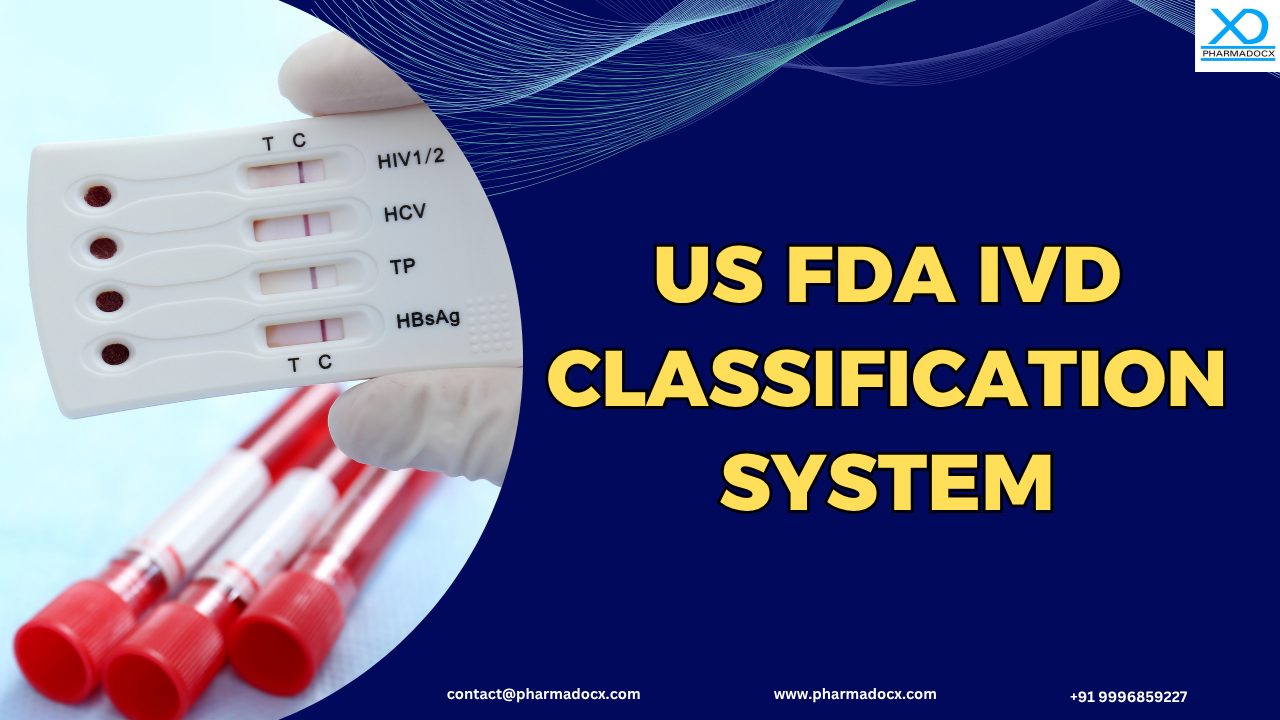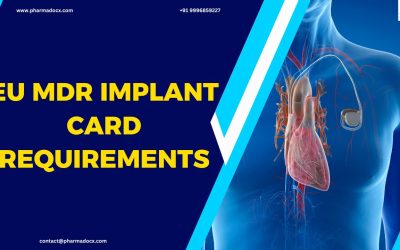In vitro diagnostics (IVDs) have a vital role in improving patient outcome and public health surveillance. IVDs are used to detect diseases, monitor health conditions, guide treatment decisions, detect diseases early on, and support precision medicine. Hence, IVDs have to be strictly regulated and monitored. In the US, IVDs are regulated by the FDA. The FDA has classified IVDs into 3 classes to streamline the regulatory pathways. The IVD class will determine the regulatory pathway required. Thus, to secure FDA approval, you must have an understanding of the FDA IVD classification system.
What are IVDs?
In vitro diagnostics (IVDs) are devices or reagents used to perform tests on samples, such as blood, urine, or tissue, outside the human body. These tests are used to detect diseases and make treatment decisions.
Key characteristics
- Non-invasive: IVDs analyze biological samples without entering the body.
- Diagnostic purpose: Used to detect infections, genetic conditions, cancers, and more.
- Settings: Can be used in clinical labs, hospitals, or even at home
US FDA IVD classification system
The FDA has classified in vitro diagnostic (IVD) devices into three classes, namely Class I, II, and III. The FDA IVD classification is based on the level of risk associated with the device. This classification system is intended to ensure that the level of regulatory control is proportional to the level of risk associated with the IVD’s intended use. The FDA IVD classes are arranged in increasing order of risk level they pose to patients and users.
Class I IVDs: Low risk
Class I in vitro diagnostic devices are considered low-risk and are subject to the least stringent regulatory oversight under FDA guidelines. Notably, Class I IVDs have the lowest risk level in the FDA IVD classification system. These devices fall under general controls, which are designed to ensure basic safety and effectiveness. Key provisions include:
- Compliance with Good Manufacturing Practices (GMP)
- Adherence to labeling requirements as per 21 CFR Part 809
- Establishment registration and device listing with the FDA
Examples of Class I IVDs: Clinical laboratory reagents, complement reagents, general-purpose laboratory equipment, such as buffered saline solutions and pipettes, certain reagents and urine pregnancy tests.
Regulatory pathway: Most Class I devices are exempt from premarket notification (510(k)). Hence, they can be legally marketed without prior FDA review, provided they meet all applicable general control requirements.
Class II IVDs: Moderate risk devices
Class II in vitro diagnostic devices are considered moderate-risk and require both general controls and special controls to ensure safety and effectiveness. While general controls apply across all device classes, special controls are tailored to address specific risks associated with Class II devices. These may include:
- Performance standards
- Post-market surveillance requirements
- FDA-issued guidance documents
- Patient registries or clinical data collection
Examples of Class II IVDs: Immunological test systems, blood glucose monitoring systems, certain types of pregnancy tests
Regulatory pathway: Class II devices typically undergo premarket notification via the 510(k) process. In this process, the manufacturer is expected to demonstrate the device is substantially equivalent to a legally marketed predicate device. This includes comparative analysis of intended use, technological characteristics, and performance data.
Class III IVDs: Highest risk devices
Class III in vitro diagnostic devices represent the highest risk category under FDA IVD classification system. Hence, Class III IVDs are subject to the highest regulatory oversight. These devices are typically life-sustaining, life-supporting, or play a critical role in preventing serious health impairment. Thus, their impact on patient outcomes demands comprehensive validation of safety and effectiveness.
Examples of Class III IVDs: HIV diagnostic assays, automated PAP smear analyzers, blood donor screening tests for infectious agents, cancer biomarkers used for diagnosis and disease monitoring
Regulatory pathway: Class III devices require premarket approval (PMA). PMA is a rigorous, science-driven process involving:
- Submission of clinical performance data
- Detailed analytical validation
- Comprehensive manufacturing and labeling documentation
- Demonstration of benefit-risk justification
Unlike the 510(k) pathway, PMA demands original evidence of safety and effectiveness. It has to be supported by clinical trial findings and post-market observations.
Overview of the US FDA IVD classification system and regulatory oversight
| Class | Risk Level | Controls Required | Examples | Premarket Pathway |
| Class I | Low | General Controls | Urine pregnancy tests, buffered saline, pipettes | Often exempt from 510(k) |
| Class II | Moderate | General + Special Controls | Blood glucose meters, immunoassays | 510(k) submission required |
| Class III | High | General Controls + Premarket Approval (PMA) | HIV diagnostic tests, genetic screening tools | PMA required |
FDA IVD class-wise regulatory requirement
US FDA IVD classification system has been formulated to streamline the regulatory pathway for IVDs. Different IVD classes have different regulatory requirements. We have broken down the regulatory requirements for you to easily understand the regulatory expectations.
- Class I IVDs: Class I IVDs are considered low-risk and are subject only to general controls. These controls include establishment registration, device listing, labeling compliance, and adherence to the Quality System Regulation (QSR). Most Class I IVDs are exempt from premarket notification (510(k)). Hence, they do not require FDA review prior to marketing. However, manufacturers must still ensure conformity with applicable standards and maintain records demonstrating compliance.
- Class II IVDs: Class II IVDs carry moderate risk and require both general and special controls to ensure safety and effectiveness. In addition to the baseline requirements of Class I, Class II devices must comply with special controls, such as performance standards, post market surveillance, and FDA-issued guidance documents. The primary regulatory pathway for Class II IVDs is the 510(k) premarket notification. Manufacturers must demonstrate substantial equivalence to a legally marketed predicate device. This involves submitting analytical performance data, technological comparisons, and labeling information.
- Class III IVDs: Class III IVDs represent the highest risk category and are typically life-sustaining, life-supporting, or critical for preventing serious health impairment. These devices require the most rigorous regulatory oversight, including general controls and a full Premarket Approval (PMA). The PMA process demands comprehensive clinical evidence to support claims of safety and effectiveness, detailed manufacturing information, and robust labeling review. Class III IVDs often undergo clinical trials under an Investigational Device Exemption (IDE) before PMA submission.
Understanding the US FDA IVD classification system is vital to identify the correct FDA IVD class of your device. Identifying the correct class will help you identify the regulatory requirements applicable to your IVD. Email at [email protected] or call/Whatsapp on 9996859227 to help you identify the correct FDA IVD class of your device. Moreover, we can help prepare the necessary documentation and file the application for you.
FAQs on FDA IVD regulatory guidelines
What is dual submission for IVD devices?
A dual submission for IVDs involves seeking both 510(k) approval and a Clinical Laboratory Improvement Amendments (CLIA) waiver simultaneously. This approach can significantly speed up the FDA approval process. However, the dual submission process requires careful planning and execution.
What is the role of clinical evidence in FDA IVD classification?
Clinical evidence plays a crucial role in securing the FDA approval for Class III IVD devices. It demonstrates that the IVD is safe and effective for its intended use. For lower-risk devices, usually less clinical data is required.
What resources help with understanding the FDA IVD classification?
FDA guidance documents, database for device classification, and webinars on this subject can be useful resources for understanding the FDA IVD classification. Moreover, hiring a regulatory consultant, such as Pharmadocx Consultants, can be useful and beneficial. Our team of experts will help you easily understand the FDA IVD classification and identify your device class.





